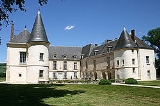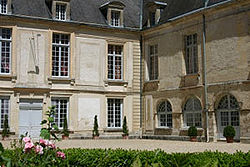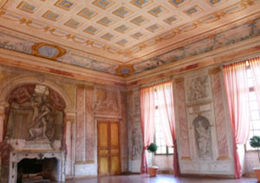
Château de Condé
Encyclopedia


Condé-en-Brie
Condé-en-Brie is a commune in the Aisne department in Picardy in northern France.-Population:-References:*...
, Aisne
Aisne
Aisne is a department in the northern part of France named after the Aisne River.- History :Aisne is one of the original 83 departments created during the French Revolution on 4 March 1790. It was created from parts of the former provinces of Île-de-France, Picardie, and Champagne.Most of the old...
, France
France
The French Republic , The French Republic , The French Republic , (commonly known as France , is a unitary semi-presidential republic in Western Europe with several overseas territories and islands located on other continents and in the Indian, Pacific, and Atlantic oceans. Metropolitan France...
, set in its park with three-hundred-year-old trees, on the Champagne route and 100 km from Paris.
The Château de Condé is a private estate, listed as a historic monument and inhabited year round. Its sumptuous 17th and 18th century interiors were created by the most prestigious artists (Watteau
Antoine Watteau
Jean-Antoine Watteau was a French painter whose brief career spurred the revival of interest in colour and movement...
, Boucher
François Boucher
François Boucher was a French painter, a proponent of Rococo taste, known for his idyllic and voluptuous paintings on classical themes, decorative allegories representing the arts or pastoral occupations, intended as a sort of two-dimensional furniture...
, Oudry
Jean-Baptiste Oudry
Jean-Baptiste Oudry was a French Rococo painter, engraver, and tapestry designer. He is particularly well known for his naturalistic pictures of animals and his hunt pieces depicting game.-Biography:...
, Servandoni
Giovanni Niccolo Servandoni
Jean-Nicolas Servan, also known as Giovanni Niccolò Servando or Servandoni was a French decorator, architect, scene-painter and trompe-l'œil specialist.He was the son of a carriage-builder at Lyon....
and others) at the behest of the Princes of Savoy
Savoy
Savoy is a region of France. It comprises roughly the territory of the Western Alps situated between Lake Geneva in the north and Monaco and the Mediterranean coast in the south....
and then the Marquis de la Faye
Jean-François Leriget de La Faye
Jean-François Leriget de La Faye was a French diplomat, wealthy landowner and art collector, poet, and member of the Académie française for a single year....
. This château evokes part of France's history, through illustrious characters like the Condés, the Savoies, Jean de La Fontaine
Jean de La Fontaine
Jean de La Fontaine was the most famous French fabulist and one of the most widely read French poets of the 17th century. He is known above all for his Fables, which provided a model for subsequent fabulists across Europe and numerous alternative versions in France, and in French regional...
, Cardinal Richelieu, Mazarin, not forgetting Olympe and her suspect "powders". Highlights include the "Watteau" wing and its recently discovered frescoes, Richelieu's bed chamber, the magnificent "trompe-l'œil" effects of Servandoni, the "little private apartments" and the outstanding drawing room decorated by Oudry
Oudry
Oudry is a commune in the Saône-et-Loire department in the region of Bourgogne in eastern France.-References:*...
.
History
This place is a very ancient one. Since the time of pre-Roman civilisation, the village of Condé-en-BrieCondé-en-Brie
Condé-en-Brie is a commune in the Aisne department in Picardy in northern France.-Population:-References:*...
was inhabited. In 500 BC. the Senones
Senones
The Senones were an ancient Gaulish tribe.In about 400 BC they crossed the Alps and, having driven out the Umbrians settled on the east coast of Italy from Forlì to Ancona, in the so-called ager Gallicus, and founded the town of Sena Gallica , which became their capital. In 391 BC they invaded...
fought nearby a battle against the Condrusi
Condrusi
The Condrusi were a Germanic tribe of ancient Belgium, which takes its name from the political and ethnic group known to the Romans as the Belgae. The Condrusi were probably located in the region now known as Condroz, named after them, between Liège and Namur...
. Traces of this presence have been found in the village and in the Château itself, which was probably a Gallo-Roman land estate. As a matter of fact, an ancient pavement of Roman times exist under the present pavement of the château.
The village derives its name from the confluence of two rivers, the Surmelin and the Dhuys which merge before feeding the river Marne
Marne River
The Marne is a river in France, a right tributary of the Seine in the area east and southeast of Paris. It is long. The river gave its name to the départements of Haute-Marne, Marne, Seine-et-Marne, and Val-de-Marne....
: Condé derives from the Celtic word
Celtic languages
The Celtic languages are descended from Proto-Celtic, or "Common Celtic"; a branch of the greater Indo-European language family...
condatum, meaning "confluent".
The castle's history during the Middle Ages was closely linked to the Coucy family
Lord of Coucy
The Lords of Coucy were a medieval lordship based on the fortress at Coucy-le-Château-Auffrique, in Picardy. The fortress was founded by Herve, archbishop of Rheims, and remained under the fluctuating control of these archbishops for some time until probably the later part of the 10th century...
. The first lord of Condé was Jean de Montmirail whose son in law was Enguerrand III, Lord of Coucy
Enguerrand III, Lord of Coucy
Enguerrand III, Lord of Coucy was the eldest son and successor of Ralph I, Lord of Coucy. He succeeded as Lord of Coucy in 1191, and held it until his death; he was also lord of Marle and Boves....
. It was he who constructed at the end of the 12th century a "keep", part of which is still to be seen, and which had 2 meters thick walls and towering chimneys.
The last heir of the House of Coucy, Marie de Coucy, moved in with her husband the Count of Bar in the 15th century. Condé was passed down through marriage to the House of Luxembourg
House of Luxembourg
The House of Luxembourg was a late medieval German dynasty, which between 1308 and 1437 ruled the Holy Roman Empire, twice interrupted by the rivaling House of Wittelsbach.-History:...
and in 1487 Marie de Luxembourg
Marie de Luxembourg
Marie of Luxembourg was a French noblewoman, the elder daughter and principal heiress of Pierre II de Luxembourg, Count of Saint-Pol, by Margaret, a daughter of Louis, Duke of Savoy...
married François de Bourbon
François, Count of Vendôme
François de Bourbon was a French nobleman. He was the Count of Vendôme.He was the son of Jean VIII, Count of Vendôme, and Isabelle de Beauveau. At his father's death when he was 7, he became Count of Vendôme...
, Count of Vendôme. Due to this marriage, the family came into contact with the royal family. Their grandson, Louis de Bourbon
Louis I de Bourbon, prince de Condé
Louis de Bourbon was a prominent Huguenot leader and general, the founder of the House of Condé, a cadet branch of the House of Bourbon.-Life:...
, was the uncle to the future king of France, Henry IV
Henry IV of France
Henry IV , Henri-Quatre, was King of France from 1589 to 1610 and King of Navarre from 1572 to 1610. He was the first monarch of the Bourbon branch of the Capetian dynasty in France....
. Louis was the first Prince of Condé
Prince of Condé
The Most Serene House of Condé is a historical French house, a noble lineage of descent from a single ancestor...
and as a child would frequently come here to hunt.
The Cardinal de Bourbon rebuilt the castle in Renaissance style
Renaissance architecture
Renaissance architecture is the architecture of the period between the early 15th and early 17th centuries in different regions of Europe, demonstrating a conscious revival and development of certain elements of ancient Greek and Roman thought and material culture. Stylistically, Renaissance...
in the 16th century. The two gatehouses are the testimony of this time. The gatehouse on the right was inhabited by the Captain of the Castle; it still contains an underground jail with an exceptional locking system. The one on the left (now a barn) was the house-keeper's lodge. The castle was one of the strongholds of the Prince de Condé, who was chief of the Protestant party during the French Wars of Religion
French Wars of Religion
The French Wars of Religion is the name given to a period of civil infighting and military operations, primarily fought between French Catholics and Protestants . The conflict involved the factional disputes between the aristocratic houses of France, such as the House of Bourbon and House of Guise...
. His wife, Eleonore de Roye, and her children often came here to get away from the troubles.
Up to 1624, the date of the marriage of Marie de Bourbon, Countess of Soissons
Marie de Bourbon, Countess of Soissons
Marie de Bourbon, Countess of Soissons was the wife of Thomas Francis, Prince of Carignano.-Biography:Marie Marguerite de Bourbon was born at the Hôtel de Soissons in Paris, was the second daughter and youngest child of Charles de Bourbon, comte de Soissons and his wife Anne de Montafié...
to Thomas, Prince of Savoie-Carignan
Thomas Francis, Prince of Carignano
Thomas Francis of Savoy was an Italian military commander, the founder of the Savoy-Carignano branch of the House of Savoy which reigned as kings of Sardinia from 1831 to 1861, and as kings of Italy from 1861 until the...
(the present Italian royal family), the castle belonged to the House of Condé. Unfortunately it was badly damaged from 1711 to 1719 by troops that were sent by Louis XIV
Louis XIV of France
Louis XIV , known as Louis the Great or the Sun King , was a Bourbon monarch who ruled as King of France and Navarre. His reign, from 1643 to his death in 1715, began at the age of four and lasted seventy-two years, three months, and eighteen days...
, who had it confiscated, during the Franco-Austrian War
Franco-Austrian War
Franco-Austrian War can refer to any of a number of wars between France and Austria:*Part of the Thirty Years' War *The Franco-Dutch War *The War of the Grand Alliance *The War of the Spanish Succession...
(the owner of the time being a cousin of an Austrian general). It was stayed in by the famous comtesse de Verrue
Jeanne Baptiste d'Albert de Luynes
Jeanne Baptiste d'Albert de Luynes, comtesse de Verrue was a French noblewoman and the mistress of Victor Amadeus II of Sardinia.-Biography:...
.


Jean-François Leriget de La Faye
Jean-François Leriget de La Faye was a French diplomat, wealthy landowner and art collector, poet, and member of the Académie française for a single year....
. He was councillor to the king and a diplomat. It was he who was in charge of finding a wife to the young King Louis XV
Louis XV of France
Louis XV was a Bourbon monarch who ruled as King of France and of Navarre from 1 September 1715 until his death. He succeeded his great-grandfather at the age of five, his first cousin Philippe II, Duke of Orléans, served as Regent of the kingdom until Louis's majority in 1723...
.
The Marquis was a member of the French Academy
Académie française
L'Académie française , also called the French Academy, is the pre-eminent French learned body on matters pertaining to the French language. The Académie was officially established in 1635 by Cardinal Richelieu, the chief minister to King Louis XIII. Suppressed in 1793 during the French Revolution,...
, a director of the French India Company
French India Company
French India Company may refer to:* French East India Company* French West India Company...
, and accordingly was a very rich man. In his mansion in Paris he often received such famous people as Voltaire
Voltaire
François-Marie Arouet , better known by the pen name Voltaire , was a French Enlightenment writer, historian and philosopher famous for his wit and for his advocacy of civil liberties, including freedom of religion, free trade and separation of church and state...
and Crébillon
Prosper Jolyot de Crébillon
Prosper Jolyot de Crébillon was a French poet and tragedian.-Life and works:He was born in Dijon, where his father, Melchior Jolyot, was notary-royal. Having been educated at the Jesuit school in the town, and afterwards at the Collège Mazarin. He became an advocate, and was placed in the office...
.
Much of the castle's final appearance is due to the Marquis' tastes. He brought to Condé the talents of the Italian architect Servandoni, a master of the "deception" style and one of the architects of the Palazzo Farnese
Palazzo Farnese, Rome
Palazzo Farnese is a High Renaissance palace in Rome, which currently houses the French embassy and the Ecole Française de Rome ....
in Rome
Rome
Rome is the capital of Italy and the country's largest and most populated city and comune, with over 2.7 million residents in . The city is located in the central-western portion of the Italian Peninsula, on the Tiber River within the Lazio region of Italy.Rome's history spans two and a half...
. He shut down the southern aisle, to allow the sun to penetrate into the rooms, and gave a symmetrical appearance to the other aisle. To achieve this he was obliged to paint false windows in the medieval part of the Castle, the walls being 2 meters thick. For the interior decoration he invited fashionable painters of the time - Lemoine
Lemoine
- People :* Adolphe Lemoine, known as Lemoine-Montigny , French comic-actor* Anne Elisabeth Lemoine, French television and radio actress* Annie Lemoine , French television actress and journalist* Émile Lemoine , French geometrician...
, his disciple Boucher
François Boucher
François Boucher was a French painter, a proponent of Rococo taste, known for his idyllic and voluptuous paintings on classical themes, decorative allegories representing the arts or pastoral occupations, intended as a sort of two-dimensional furniture...
, Watteau
Antoine Watteau
Jean-Antoine Watteau was a French painter whose brief career spurred the revival of interest in colour and movement...
and his disciple Lancret
Nicolas Lancret
Nicolas Lancret , French painter, was born in Paris, and became a brilliant depicter of light comedy which reflected the tastes and manners of French society under the regent Orleans....
and last but not least Jean-Baptiste Oudry
Jean-Baptiste Oudry
Jean-Baptiste Oudry was a French Rococo painter, engraver, and tapestry designer. He is particularly well known for his naturalistic pictures of animals and his hunt pieces depicting game.-Biography:...
.
At a later date the castle belonged to the Count de la Tour du Pin Lachaux, through his marriage with the niece of the Marquis de la Faye. In 1814, the Countess de Sade, the daughter in law of the famous Marquis de Sade
Marquis de Sade
Donatien Alphonse François, Marquis de Sade was a French aristocrat, revolutionary politician, philosopher, and writer famous for his libertine sexuality and lifestyle...
inherited Condé from her cousin La Tour du Pin. Since this time and up to 1983, the castle has remained the property of the Sade family who restored it with much care, after the two World Wars.
Restoration
In 1983, Alain Pasté de Rochefort purchased the chateau which had been for sale for many years. Here he did not feel a stranger since his ancestor Captain Pasté was in the 16th century one of the two captains of the first Prince of Condé's personal guard. He was restless and, with the help of the Administration of Historical Monuments, started a series of works: the roofs were repaired, including those of dependencies such as “La Porterie” and “La Capitainerie” as well as the 17 fireplaces, gutters and stonework. Restoration of the façades could then begin, along with the grand staircase or the small apartments whose woodwork and parquet needed to be partly dismantled. The Watteau wing, which had suffered in both wars, had its colours restored. Each room evokes Watteau and his followers (Lancret and Pater) who painted landscapes, “fêtes galantes”, tales by Jean de la Fontaine painted on the walls. While some paintings were hidden (behind wallpaper or mirrors), they were later discovered after many years of restoration.Book sources
- Glorieux, Guillaume, 2004: Le Château de Condé – Demeure des Princes. Paris: Somogy. ISBN 2-85056-759-0.

